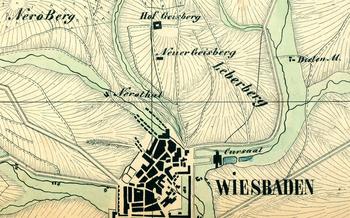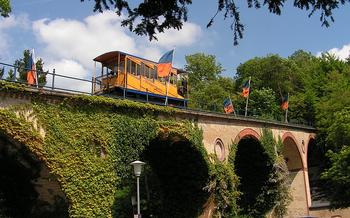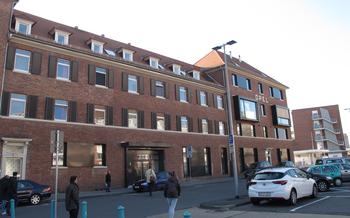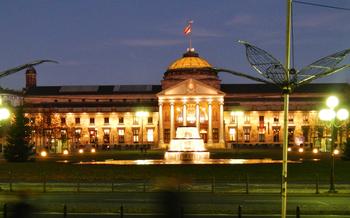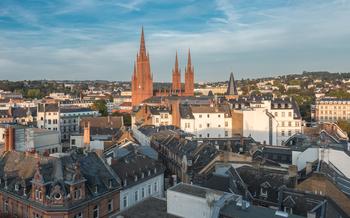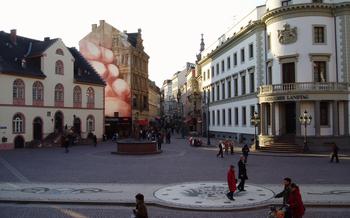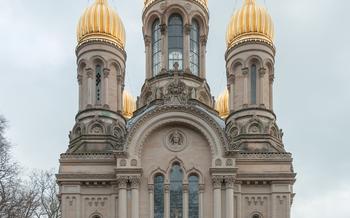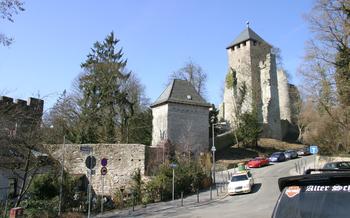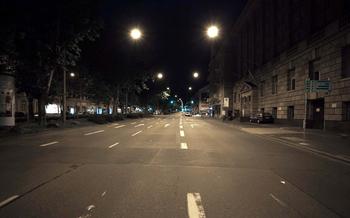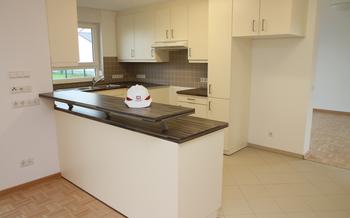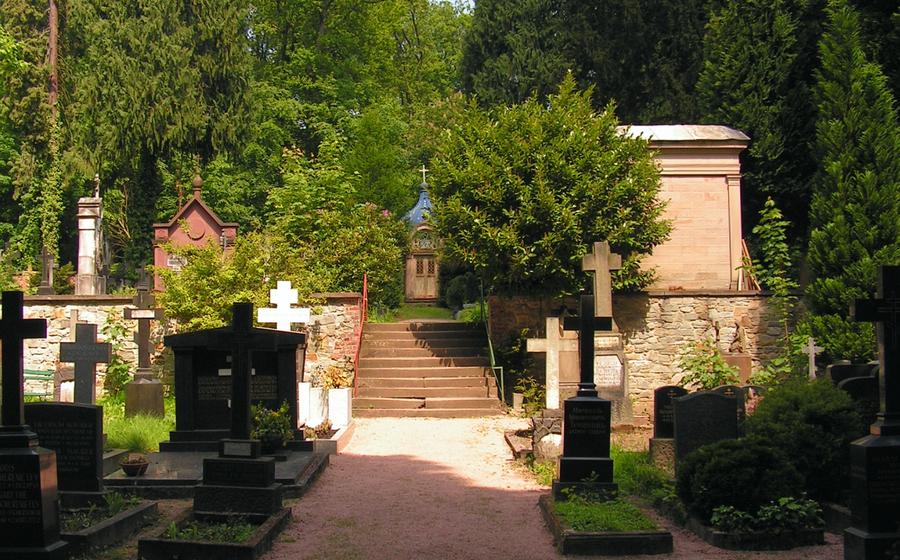
Neroberg
- Neroberg Mountain
- Nerobergbahn
- Neroberg Tower
- Russian Orthodox Church Wiesbaden
- Jagdschloss Platte
- Wiesbaden Kurhaus
- Schloss Freudenberg
- Museum Wiesbaden: A Treasure Trove of Art and Natural Wonders
- Wilhelmstrasse: Shopping and Culture in the Heart of Wiesbaden
- Kochbrunnen
- Insider Tip: Exploring Wiesbaden's Hidden Gems
Neroberg Mountain
Neroberg Mountain, a majestic elevation standing tall in the heart of Wiesbaden, holds a rich tapestry of history, natural wonders, and panoramic vistas. Its historical significance dates back to the Roman Emperor Nero, who is believed to have built a villa on its slopes during the 1st century AD, lending the mountain its name. Neroberg's unique geological formations, including quartzite cliffs and mineral springs, have led to the creation of the Neroberg Nature Park, a haven for nature enthusiasts and hikers. The park boasts a diverse array of flora and fauna, including rare orchid species and protected birdlife. Visitors are rewarded with breathtaking panoramic views of Wiesbaden and the Rhine Valley, making Neroberg Mountain a popular destination for those seeking tranquility and scenic beauty. Whether you choose to ascend on foot, by car, or take the charming Nerobergbahn funicular railway, the journey to the summit promises an unforgettable experience.
Nerobergbahn
The Nerobergbahn is a historical funicular railway that has been transporting passengers up the Neroberg Mountain since 188It is one of the oldest and most iconic funiculars in Germany, offering breathtaking views of Wiesbaden and the Rhine Valley during its scenic journey.
The railway consists of two cars, each accommodating up to 50 passengers, that counterbalance each other as they ascend and descend the mountain. The journey takes approximately 5 minutes, covering a distance of 438 meters with an elevation gain of 83 meters.
To ensure a safe and comfortable ride, the Nerobergbahn underwent a comprehensive renovation in 201The original cars were replaced with new, modern ones that feature panoramic windows, providing passengers with unobstructed views of the surrounding landscape.
The Nerobergbahn operates daily, with varying frequencies depending on the time of day. Single and round-trip tickets are available for purchase at the lower station, and discounts are offered for families and groups.
Here are some insider tips for making the most of your Nerobergbahn experience:
- Arrive early to avoid crowds, especially during peak tourist season.
- Choose a seat on the uphill side of the car for the best views.
- Take your time to enjoy the journey and capture the stunning vistas of Wiesbaden and the Rhine Valley.
- Combine your Nerobergbahn ride with a visit to the Neroberg Tower, the Opel-Zoo, or the Neroberg Park for a comprehensive Neroberg experience.
Neroberg Tower
The Neroberg Tower, a prominent landmark of Wiesbaden, stands atop Neroberg Mountain, offering breathtaking panoramic views of the city and the surrounding region. Constructed in 1888, the tower combines architectural elegance with historical significance. Its design, featuring a mix of Romanesque and Gothic elements, reflects the prevailing architectural style of the late 19th century.
Ascend the tower's 146 steps or take the convenient elevator to reach the observation deck, where a stunning 360-degree panorama awaits. From this vantage point, visitors can admire the vibrant cityscape of Wiesbaden, with its elegant buildings and the winding Rhine River flowing through it. The Taunus Mountains provide a picturesque backdrop, with lush forests and rolling hills stretching into the distance.
Throughout history, the Neroberg Tower has played a significant role. During World War II, it served as an observation post, and its sturdy structure withstood several aerial attacks. Today, it stands as a symbol of resilience and a testament to Wiesbaden's rich history.
Admission to the tower is reasonably priced, and it is open to the public throughout the year. Visitors can enjoy the views during the day or take advantage of the evening hours when the city lights up, creating a magical atmosphere. Whether you're a history buff, a nature enthusiast, or simply seeking a unique experience, the Neroberg Tower is a must-visit attraction in Wiesbaden.
Russian Orthodox Church Wiesbaden
A Symbol of Russian Culture and Spirituality
The Russian Orthodox Church in Wiesbaden, Germany, stands as a testament to the rich cultural heritage of the Russian community in the city. Built in the late 19th century, this magnificent structure boasts a distinctive architectural style that blends traditional Russian elements with Byzantine influences. Its onion domes, colorful facade, and intricate detailing create a visually striking landmark that commands attention in the heart of Wiesbaden.
Inside the church, visitors are greeted by a serene and spiritual atmosphere. The iconostasis, a wall of icons that separates the sanctuary from the nave, is a masterpiece of religious art, featuring intricate paintings of saints and biblical scenes. The vaulted ceilings and stained glass windows further enhance the sacred ambiance, creating a space that invites contemplation and reflection.
Beyond its religious significance, the Russian Orthodox Church in Wiesbaden serves as a cultural center for the Russian community. Regular services, festivals, and events are held to celebrate Russian traditions and foster a sense of belonging among its members. The church also hosts concerts, exhibitions, and lectures on Russian culture, providing a platform for dialogue and understanding between different communities.
For visitors interested in exploring the cultural side of Wiesbaden, the Russian Orthodox Church is a must-visit destination. Its unique architecture, rich history, and vibrant community offer a glimpse into the diverse cultural tapestry of this cosmopolitan city.
Practical Information
- Visiting Hours: The church is open to the public daily from 10 am to 6 pm.
- Dress Code: Visitors are expected to dress modestly and respectfully when entering the church.
- Accessibility: The church is wheelchair accessible, with ramps and elevators available.
Jagdschloss Platte
Jagdschloss Platte is a former hunting lodge situated atop the Neroberg, offering breathtaking views of Wiesbaden and the surrounding countryside. Constructed in 1750, the Baroque-style palace boasts an elegant facade, ornate interiors, and a rich history. Originally used as a hunting retreat by the Counts of Nassau, the palace underwent renovations in the 19th century, transforming it into a popular destination for royalty and nobility. Today, Jagdschloss Platte serves as a renowned restaurant and event venue, hosting weddings, corporate functions, and special celebrations.
Visitors to Jagdschloss Platte are captivated by its idyllic setting amidst the Neroberg Park. The palace grounds feature meticulously landscaped gardens, serene ponds, and winding paths, inviting guests to explore and relax. Inside, the palace exudes an atmosphere of grandeur, with its opulent chandeliers, marble fireplaces, and intricate wall paintings. The restaurant offers a culinary journey, tantalizing taste buds with regional delicacies and modern gastronomic creations, all while immersing diners in the palace's historical charm.
Jagdschloss Platte is more than just a historical landmark; it's a vibrant cultural hub that hosts a variety of events throughout the year. From classical music concerts to art exhibitions, the palace provides a platform for local and international artists to showcase their talents. Special events, such as themed dinners and seasonal celebrations, create unforgettable experiences for guests, allowing them to step back in time and immerse themselves in the palace's rich heritage.
Practical Information:
- Reservations: Advance reservations are recommended, especially for special events and weekends.
- Menu Highlights: Don't miss the Wildschweinbraten (wild boar roast) and the Tafelspitz (boiled beef) for a taste of traditional German cuisine.
- Accessibility: Jagdschloss Platte is accessible by car, with limited parking available on-site. Public transportation options are also available, with bus stops nearby.
Wiesbaden Kurhaus
A symbol of Wiesbaden's grandeur and cultural heritage, the Kurhaus stands as a testament to the city's rich history. Constructed in the late 19th century, this palatial building boasts a captivating architectural blend of Neoclassical and Art Nouveau styles. Its grand facade, adorned with intricate details and sculptures, reflects the opulence and elegance of a bygone era.
Inside the Kurhaus, visitors are greeted by a world of splendor and sophistication. The grand halls, including the awe-inspiring Festsaal and the opulent Spielbank Wiesbaden casino, transport visitors back to a time of lavish balls and glittering social gatherings. The Festsaal, with its soaring ceilings, crystal chandeliers, and ornate wall paintings, provides a breathtaking setting for concerts, galas, and other prestigious events.
Beyond its architectural marvels, the Kurhaus is renowned for its vibrant cultural scene. Throughout the year, the Kurhaus plays host to a diverse array of events, from classical concerts and ballet performances to art exhibitions and international conferences. Its reputation as a cultural hub attracts visitors from around the world, eager to experience the magic that unfolds within its walls.
Whether you're seeking a night of entertainment, a glimpse into Wiesbaden's history, or simply a chance to admire architectural grandeur, the Wiesbaden Kurhaus is an unmissable destination. Immerse yourself in its opulent ambiance, revel in its cultural offerings, and create memories that will last a lifetime.
Schloss Freudenberg
Schloss Freudenberg, a magnificent castle perched atop a hill in Wiesbaden, stands as a testament to the city's rich history and architectural heritage. Originally constructed in the 12th century as a fortification, the castle has undergone several transformations over the centuries, reflecting the evolving tastes and styles of its successive owners.
In the 16th century, the castle was significantly expanded and embellished in the Renaissance style, featuring elaborate stone carvings and decorative elements. During the 19th century, it underwent further renovations and additions, resulting in a harmonious blend of architectural styles that showcases the castle's long and storied history.
Today, Schloss Freudenberg serves as a museum, housing a diverse collection of art and antiques that spans various periods and genres. Visitors can explore the castle's grand halls and chambers, which are adorned with intricate tapestries, opulent furnishings, and priceless works of art.
Among the highlights of the museum's collection are paintings by renowned masters such as Lucas Cranach the Elder, whose works offer a glimpse into the artistic traditions of the German Renaissance. The museum also features a collection of medieval artifacts, including armor, weapons, and domestic objects, providing insights into the daily life and culture of the castle's former inhabitants.
In addition to its permanent collection, Schloss Freudenberg also hosts temporary exhibitions and special events throughout the year. These exhibitions often focus on specific themes or periods in art history, showcasing the works of both established and emerging artists.
For visitors interested in delving deeper into the history and significance of Schloss Freudenberg, guided tours are available. These tours offer a fascinating narrative of the castle's past, highlighting its architectural features, historical events, and the stories of the people who have called it home.
Whether you're an art enthusiast, a history buff, or simply someone who appreciates the beauty of historic architecture, Schloss Freudenberg is a must-visit destination in Wiesbaden. Its unique blend of history, art, and breathtaking views makes it a truly unforgettable experience.
Practical Information:
- Admission Fees: Adults: €6, Children (6-17 years): €3, Family Ticket (2 adults + 2 children): €15
- Opening Hours: Tuesday-Sunday: 11 am - 5 pm (Closed on Mondays)
- Accessibility: The castle is accessible by foot, car, or public transportation.
Museum Wiesbaden: A Treasure Trove of Art and Natural Wonders
Immerse yourself in the world of art, history, and natural wonders at the Museum Wiesbaden, a cultural gem in the heart of the city.
The Museum Wiesbaden boasts an impressive collection that spans various disciplines, showcasing masterpieces from different eras and genres. Art enthusiasts will marvel at the works of Lucas Cranach the Elder, whose paintings depict biblical scenes with intricate details and vibrant colors. The museum also houses a remarkable collection of sculptures, including works from the Middle Ages to the present day.
In addition to its art collection, the Museum Wiesbaden is renowned for its Natural History Museum, which houses a vast array of exhibits that explore the diversity of life on Earth. Discover the wonders of the animal kingdom, from majestic lions and elephants to fascinating insects and reptiles. The museum also features an extensive collection of fossils, shedding light on the evolution of life over millions of years.
The Museum Wiesbaden is not just a place to admire artifacts; it also offers a range of educational programs and workshops designed to engage visitors of all ages. Participate in guided tours, hands-on workshops, and interactive exhibits that bring the museum's collections to life. Learn about the history, techniques, and cultural significance of the artworks and scientific specimens on display.
Practical Information: - Location: Friedrich-Ebert-Allee 2, 65185 Wiesbaden, Germany - Admission Fees: Adults €12, Reduced €6, Children and Jugendliche frei - Opening Hours: Tuesday to Sunday 10 am to 6 pm, Closed on Mondays - Accessibility: The museum is wheelchair accessible and offers accessible tours and programs.
Wilhelmstrasse: Shopping and Culture in the Heart of Wiesbaden
Wilhelmstrasse, a vibrant and historic street in the heart of Wiesbaden, offers a captivating blend of shopping, culture, and architectural landmarks. Stroll along this charming pedestrian zone and admire the elegant 19th-century buildings that line the street, each with its own unique story to tell.
Wilhelmstrasse is a haven for shopaholics, with a diverse range of boutiques, specialty stores, and international brands catering to every taste and budget. From high-end fashion and accessories to charming souvenir shops, you're sure to find something to suit your fancy.
Interspersed among the shops are cozy cafes and inviting restaurants, offering a delightful respite from your shopping spree. Indulge in a traditional German coffee and cake at one of the many cafes, or savor a delicious meal at a restaurant with outdoor seating, allowing you to soak in the lively atmosphere of the street.
Wilhelmstrasse is also home to several cultural attractions, including the Marktkirche, a magnificent neo-Gothic church with intricate stained-glass windows, and the Stadtschloss, a former palace that now houses the Hessian State Parliament. Take a moment to explore these landmarks and delve into the rich history of Wiesbaden.
As you stroll along Wilhelmstrasse, be sure to look up and admire the architectural details of the buildings, many of which showcase intricate facades, elaborate balconies, and decorative elements. The street is a true testament to Wiesbaden's architectural heritage and is a delight for photography enthusiasts.
Whether you're looking to shop, soak in the culture, or simply people-watch, Wilhelmstrasse is the perfect place to experience the vibrant energy of Wiesbaden.
Kochbrunnen
The Kochbrunnen, or "boiling spring," is a historical thermal spring and one of Wiesbaden's most iconic landmarks. Located in the heart of the city, the Kochbrunnen is a testament to Wiesbaden's rich spa heritage and natural beauty.
The spring was discovered in 1607 and quickly became renowned for its therapeutic properties. The water, which emerges from the ground at a temperature of 66°C (151°F), is rich in minerals and has been used for centuries to treat a variety of ailments, including rheumatism, arthritis, and skin conditions.
The Kochbrunnen is surrounded by beautiful parks and gardens, offering a tranquil oasis in the midst of the bustling city. Visitors can relax on benches and admire the 12-foot-high fountain that marks the spring. The surrounding area is also home to several thermal baths and spa facilities, where visitors can indulge in a variety of treatments and therapies.
Practical Information:
- Location: The Kochbrunnen is located in the center of Wiesbaden, near the Kurhaus and the Wilhelmstrasse shopping street.
- Accessibility: The Kochbrunnen is easily accessible by foot or public transportation. It is also close to several parking garages.
- Spa Treatments: Visitors can enjoy a variety of spa treatments and therapies at the nearby thermal baths, including massages, facials, and mud baths.
Insider Tip: Exploring Wiesbaden's Hidden Gems
Beyond the well-known attractions, Wiesbaden offers a treasure trove of hidden gems waiting to be discovered. Here are some insider tips for exploring the city like a local:
-
Secret Viewpoints: For breathtaking panoramic views, head to the Philosophenweg (Philosopher's Path), a scenic trail along the Neroberg Mountain. Don't miss the unique perspective from the Bismarck Tower, offering stunning vistas of the city and the Rhine Valley.
-
Hidden Parks: Escape the hustle and bustle in the tranquil Luisenpark, home to beautiful gardens, a rose garden, and a small zoo. For a more secluded retreat, explore the Arboretum, a botanical garden featuring a diverse collection of trees and plants.
-
Local Delicacies: Indulge in Wiesbaden's culinary scene by trying the local specialty, "Handkäs mit Musik," a pungent cheese served with onions and vinegar. For a sweet treat, sample the traditional "Kreppel," a filled donut, at one of the city's many bakeries.
-
Cultural Events: Experience Wiesbaden's vibrant cultural side by attending one of the many festivals and events throughout the year. Highlights include the Rheingau Musik Festival, featuring classical music concerts in unique venues, and the Wiesbaden Christmas Market, offering a festive atmosphere and local delicacies.
-
Alternative Sightseeing: Discover Wiesbaden's lesser-known attractions, such as the Museum of Nature and Hunting, showcasing taxidermy exhibits and hunting artifacts. For a glimpse into local history, visit the City Museum, which tells the story of Wiesbaden from its Roman origins to the present day.
